From Wikipedia Entries:
- Dillon was founded in the Beaverhead Valley as a railroad town in 1880 by Union Pacific Railroad President Sydney Dillon.
- The location of Dillon was selected by the railroad because of its close location to gold mines in the area.
- Gold was first discovered in the Dillon area at Grasshopper Creek in 1862.
- The last real gold rush in the Dillon area happened in the Argenta area in 1920 and lasted for 30 years.
- The first ore that was discovered in the Dillon areas was silver. Gold was found soon after and this discovery caused people to come to the area in droves.
- Dillon served as a central location for transporting goods to boom towns such as Bannack, Argenta, Glen, and Virginia City.
- In 1881 Dillon became part of a contentious battle with Bannack to become the county seat of Beaverhead County.
- The first brick building was built in the frontier town of Dillon in 1882.
- In 1884, Dillon became an incorporated town and began building sidewalks and permanent dwellings for the residents.
- While many of the gold mining towns around Dillon died, Dillon was able to stay a thriving town due to the railroad and talc mining in the area.
- The cattle industry was established in 1865 in what would become the city of Dillon.
- With a large sheep-ranching community in the Dillon area, Dillon was once the largest exporter of sheep wool in Montana.
- The Montana Normal College was established as a teaching college in 1892, and is still functioning as a college renowned for its Education program.
Beaverhead County is the largest county by area in the U.S. state of Montana. As of the 2010 census, the population was 9,246. The county seat is Dillon. The county was founded in 1865.
Much of the perimeter of the county is the Continental Divide, including all of its border with the state of Idaho. The divide heads east into Montana at the county border with Ravalli County, between Lost Trail Pass and Chief Joseph Pass.
The county name is derived from a rock formation, which the Shoshone described as being shaped like a beaver's head.
The original county seat was the gold-mining town of Bannack. In 1881 it was moved to Dillon.

